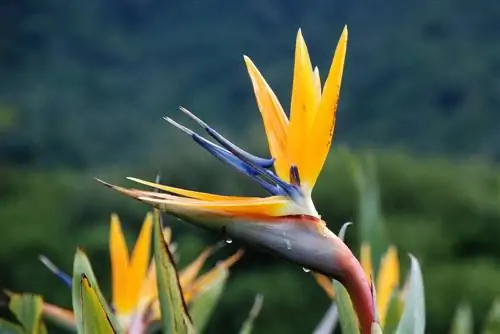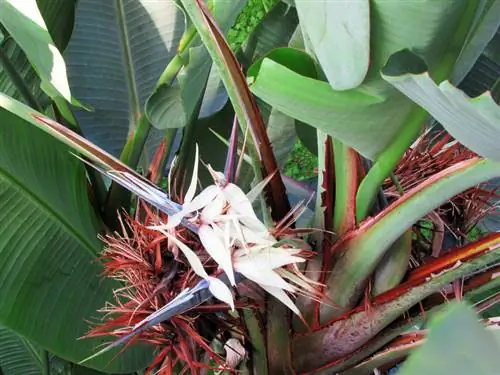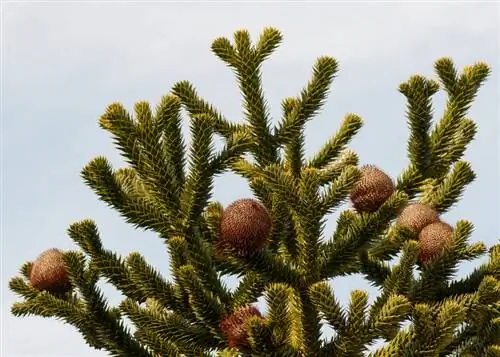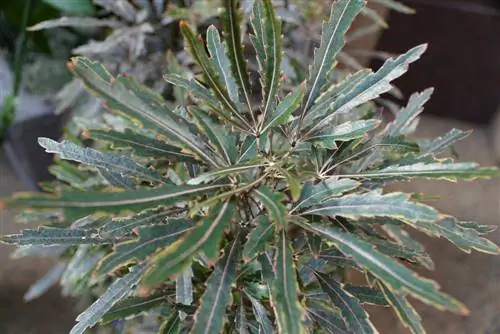- Author admin [email protected].
- Public 2024-01-02 03:03.
- Last modified 2025-06-01 06:02.
With its paradisiacal flowers, the Strelitzia is one of the most sought-after exotic ornamental plants. Here we have put together an overview of everything you need to know about cultivating South African beauty in your room or winter garden.
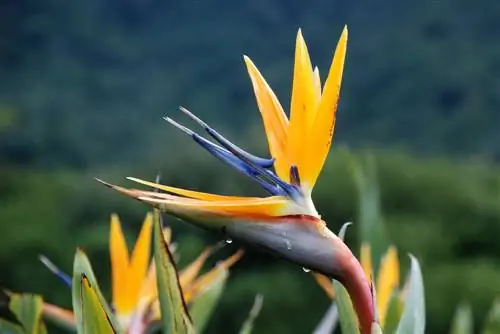
How do I properly care for a Strelitzia?
The Strelitzia, also known as the bird of paradise flower, is an exotic ornamental plant from South Africa. It requires a bright location, temperatures between 8-18°C, nutrient-rich and permeable soil, regular watering without waterlogging, and little pruning care. Ideal varieties for indoor cultivation are the royal strelitzia and the rush strelitzia.
Meaning
The name of the Strelitzia doesn't seem to fit its South African home at all - in any case, it sounds anything but African, but rather German. And this impression is not misleading. At the end of the 18th century, the flower with its artistic-looking blossoms came to Joseph Banks, the head of the London Botanical Garden, who presented the exotic novelty to the wife of the current British King George III. adored. It was the German Sophie Charlotte of Mecklenburg-Strelitz - so it came about that the Strelitzia was named after a German noble family.
The German, non-scientific name of the best-known species, the royal strelitzia, is, as usual, somewhat emotionally descriptive in nature - it is also called bird of paradise or parrot flower because its flower with its colorful, radiating bracts and bracts corresponds to the Profile of an exotic bird's head with a long crest of feathers.read more
Growth
The Strelitzia is a perennial and, depending on the variety, grows with or without stem formation. All species form clumps via rhizomes, i.e. round “nests” that do not spread widely via runners. Strelitzia varieties vary in height from two to ten meters - so they can become very impressive plants. Of course, they can only be cultivated in this form outdoors or, in this country, in large greenhouses in botanical gardens.
Overview again:
- Perennial
- some varieties with, some without stem formation
- Heights between 2 and 10 meters
leaves
The tree-like Strelitzias form basal leaves in a two-row arrangement. They are very large, green, long-stemmed and have a leathery texture. They somewhat resemble the leaves of banana trees. The leaves of the rush strelitzia have a slightly different appearance, namely a rush-like one: their long, needle-like fronds hardly have a leaf blade and are also colored much brighter green.
Bloom
The flower is certainly one of the most characteristic features of the Strelizia. The royal strelitzia in particular, with its magnificent, artfully structured inflorescence, is also very popular as a cut flower.
Botanical properties of the Strelitzia flower are its hermaphrodite sexual position, its zygomorphic structural symmetry and its threefold nature.
The most striking visual feature is the boat-shaped bract, which envelops the inflorescence in all varieties and forms the basis for the radiating overall structure. In addition, the bract with a length of up to 10 centimeters ensures the impressive overall appearance of the flower. The bracts sitting on the bract are arranged in two circles, also pointed and long and each of different sizes.
The colors also make the strelitzia blossom an attraction: the spectrum ranges from bright orange to maize yellow with individual streaks in blue-purple or white with blue-green to ice blue accents.
The characteristics of the Strelitzia flower:
- artful, plume-like structure reminiscent of an exotic bird's head
- hermaphrodite, zygomorphic, tripartite
- large, boat-shaped bract
- bright colors from orange-blue to white-blue
Flowering time
When it comes to flowering time, the first thing that is important for the Strelitzia is the first flowering during its lifetime - it only produces its first flower when it is around 4 years old. The flowering phase usually lasts around 4 weeks and falls into a different phase of the year depending on the variety. Generally, the flowering phase occurs in the first half of the year between December and October.
The royal strelitzia, for example, can delight with its flowers during the Christmas season if it is kept in a warm place in winter. If it is cooler, it can wait until early summer. The rush strelitzia, on the other hand, generally shows its flowers later, between May and October.
To remember:
- Strelizia only produces its first flowers when it is 4 years old
- Flowering phase about 4 weeks
- Depending on the variety, the flowering phase occurs between December and October
read more
Pull
If you would like to keep a magnificent Strelitzia at home, as with all exotic southern plants, it must be in a pot. The African beauty is not hardy, so she has to spend our frosty winter indoors. An alternative, which may be less available to you as a hobby gardener, is an indoor bed in the greenhouse or winter garden.
What you also need to think carefully about is the choice of variety. Because these tree-like varieties cannot be kept in the house or apartment. They are therefore most likely to be found in botanical gardens, where meter-high greenhouses are available.
If you have a tall winter garden, you could also consider growing a not-so-tall tree strelitzia, for example. However, the white or mountain strelitzia are probably only suitable for cultivation in public display greenhouses. Only the stemless species are suitable as houseplants, namely the king strelitzia and the rushes, which are considered the most beautiful and popular anyway -Strelitzia.
- Strelitzia not hardy - indoor requirement at least in winter
- tree-like strelicia only suitable for owners of tall winter gardens
- stemless strelicia suitable for indoor cultivation
Which location is suitable?
Strelitzias prefer a bright, spacious place with moderate warmth. Because even if they are not frost hardy, temperatures that are too high are not suitable for the local culture - they lead to a growth and size that is difficult to manage. It is best to offer your Strelitzia a temperature range between 8 and 18 °C. But it shouldn't get any cooler in winter. In summer you can also put the plant outside - depending on its size. But avoid full sun.
Important: After the flowers have opened, do not move the Strelitzia anymore - this will stop flowering!
Location:
- Bright
- not too cold and not too warm (8-18°C)
- don't move after the flowers open
read more
What soil does the plant need?
As a substrate, strelitzias prefer a nutrient-rich soil with a certain amount of clay - but good permeability must also be ensured, as their fleshy roots cannot tolerate any waterlogging. It's best to prepare a mixture of loamy soil, mature compost, if necessary some nourishing horse manure and some sand to loosen it up.
Repotting
Fortunately, the Strelittzie doesn't need to be repotted very often. Given the impressive size and the delicate root ball, this is not an entirely trivial undertaking. A pot change is usually only necessary every three years, and this is less due to increased crowding than because of the depleted nutrients in the substrate - even with regular fertilization, the substrate will eventually run out. You can fill the new pot with a fresh soil mixture with organic long-term fertilizer such as compost and stable manure.
But be extremely careful with the fleshy roots when repotting - the Strelizia does not tolerate injuries to the base well.read more
Watering Strelizia
You should water the Strelitzia regularly but moderately. The root ball should not dry out, as this can lead to leaf drop. But waterlogging is even more damaging - over time, the roots can begin to rot. So always make sure that the root ball is somewhat dry before the next watering.
Cut Strelizia correctly
The Strelitzia does not need great pruning care. To keep it he althy and vital, it is enough to regularly remove the dried, old leaves. This way she gets enough light and air again for fresh development.read more
Brown leaves
Brown leaves are not always just old and therefore need to be cut out. They can also be an indication of care errors - but not of a specific disease or pest infestation. The reasons for brown Strelitzia leaves are usually harmless.
Possible reasons are:
- Draft
- too dry or too wet substrate
- Overfertilization
- Sunburn
One reason could be, for example, drafts. They don't like strelitzias at all and can react sensitively. So make sure the air environment is as calm as possible.
A substrate that is too dry or too wet can be a little more critical. Regular waterlogging can lead to root rot, which of course affects the plant. If in doubt, repotting is necessary.
You must also not over-fertilize the Strelitzia - it can also react to this with brown leaves.
Brown leaves could also simply be burnt leaves - especially if the Strelitzia is suddenly placed in the sun after winter quarters, it can suffer sunburn.read more
Diseases
In general, the Strelitzia is a pleasantly uncomplicated plant when it comes to diseases and pests. If she shows he alth problems, it is usually limited and has no truly life-threatening or uncorrectable reasons. What can generally affect her is the following:
- Waterlogging - possibly Septoria mushroom
- dry, drafty room air
- Spider mites
- Scale insects
If the Strelitzia is exposed to waterlogging too often, as mentioned, the roots can rot and lead to brown leaves. In the worst, but rather rare, case, an infestation of the Septoria fungus can also follow. Then you have to remove the affected, yellowish-brownish leaves and, if necessary, use a fungicide (€62.00 on Amazon).
When the air is dry and drafty, the Strelitzia usually complains that the leaves turn brown. In this case, change them as much as possible.
But a spider mite infestation can also be caused by dry indoor air. The best way to combat spider mites is to spray and wrap the plant under foil. As a result, the pests usually die within a week.
Scale insects cause a brownish discoloration of the leaf stems and subsequent shedding of leaves. You should first collect the annoying parasites as thoroughly as possible and then spray the plant with a water-oil solution. It causes the scale insects to suffocate. Theread more
Propagate Strelizia
Since the Strelitzia forms a clumpy rhizome root network, the dividing method is best suited for its propagation. To do this, take the plant out of its pot in spring and cut off part of the root ball and the associated above-ground plant part from the mother plant. Place this in its own pot with nutrient-rich, permeable substrate. Beforehand, the roots should be dusted with charcoal powder - this prevents root rot.
You should not initially place the divided young plant in full sun. Water regularly, but always avoid waterlogging. After about 5 weeks you can transplant the young Strelitzia into a new pot and continue cultivating as usual.read more
Tip:
As mentioned in several of the previous sections, the Strelitzia tolerates dry indoor air poorly, has brown leaves and is more susceptible to scale insect infestation. You should therefore guarantee it a permanently high level of humidity. So that you don't have to constantly actively humidify the air when cultivating in the living area, simply choose the right room: the air humidity in the kitchen or bathroom is usually higher than in the living room or bedroom. In addition, the exotic strelitzia blossom can create an attractive oasis atmosphere, especially in the bathroom!
Varieties
The range of varieties in the Strelitzia genus is manageable. There are exactly 5 types:
King Strelitzia (Strelitzia reginae)
It is probably the most beautiful and best-known of the Strelitzia species. This is where their royal name comes from. However, it is also called the bird of paradise flower because of its particularly magnificent, large flowers, whose ray structure is reminiscent of a long beak and a comb-like plume. The flowers appear bright orange with dark blue accents on the lower bracts for about 4 weeks between December and May. As a stemless Strelitzia species, it only grows to around 2 meters tall.
Bulrush Strelitzia (Strelitzia juncea)
With its long, grass-like, needle-shaped, almost leafless fronds, the rush strelitzia is probably the most unusual species among the strelitzias and its appearance is particularly suitable for grass lovers. In addition to the royal strelitzia, it is the second stemless species and can be easily cultivated indoors. It also only grows to around 2 meters tall. Its flowers are also very similar to those of the royal strelitzia. However, they appear much later in the year, around May to October.
White Strelitzia (Strelitzia alba)
Their name suggests that this type of strelitzia delights with white flowers. Like the orange ones, these also have blue accents in the lower part of the petals, but usually in a much lighter tone. The flowers appear between May and June. The White Strelitzia is one of the three stem-forming, tree-like varieties. It can grow up to 10 meters high and is therefore less suitable for home cultivation, but rather only for large greenhouses.
Tree Strelitzia (Strelitzia nicolai)
With the tree Strelitzia we come to the second stem-forming Strelitzia species. With a maximum height of 12 meters, it is the largest of all, and its palm-like fronds are also particularly large. It goes without saying that it is not suitable for growing in pots in the room. In our part of the world, it produces its mostly white-blue flowers when cultivated in a greenhouse between April and July, but in the wild in southern climes it can be grown all year round about blooming.
Mountain Strelitzia (Strelitzia caudata)
With a moderate growth height of up to 6 meters, this is the smallest stem-forming Strelitzia species that can also be kept in a high, private winter garden. In this country, their flowers usually appear in the spring and early summer months and are noticeable due to their deep blue, rarely white, bracts.

